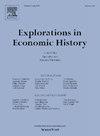Socioeconomic differences in population growth in 19th century Liaoning, China: a decomposition
IF 1.7
1区 历史学
Q1 ECONOMICS
引用次数: 0
Abstract
We decompose population growth in 19th century Liaoning in northeast China into the shares accounted for by different socioeconomic groups, and by time periods with different economic conditions as reflected in grain prices. This decomposition reveals who benefitted the most when social and economic conditions supported population increase. Previous studies of one region for which relevant data are available, northeast China, showed that birth and death rates varied according to community, household, and individual context, but did not investigate differences in growth rates by context, or the shares of population growth accounted for by each group. Using the same dataset, we decompose population growth by synthesizing differentials in mortality and fertility into estimates of implied growth rates of population subgroups and the shares of total population growth they account for. This decomposition framework can be applied in any setting where household registers or other sources allow for the measurement of the mortality and fertility rates of population subgroups at fixed points of time. We show that advantaged socioeconomic groups contributed disproportionately to population growth in northeast China, and that more growth took place when harvests were good, that is when grain prices were low. Even though mortality and fertility responses to grain price fluctuations varied across subgroups, there is no evidence of differential response of growth rates to these fluctuations. We conclude by discussing the implications of our findings for our understanding of population dynamics in the late Qing.
19世纪辽宁人口增长的社会经济差异:一个分解
我们将19世纪东北辽宁省的人口增长分解为不同社会经济群体所占的份额,以及不同经济条件下粮食价格所反映的时期。这种分解表明,当社会和经济条件支持人口增长时,谁受益最大。先前对中国东北一个有相关数据的地区的研究表明,出生率和死亡率因社区、家庭和个人背景而异,但没有调查不同背景下增长率的差异,也没有调查每个群体占人口增长的份额。使用相同的数据集,我们通过综合死亡率和生育率的差异来分解人口增长,从而估计人口子群体的隐含增长率及其占总人口增长的份额。这一分解框架可适用于户籍或其他来源允许在固定时间点测量人口分组死亡率和生育率的任何环境。我们的研究表明,在中国东北,社会经济条件优越的群体对人口增长的贡献不成比例,而且在粮食收成好的时候,也就是粮食价格低的时候,人口增长会更多。尽管死亡率和生育率对粮食价格波动的反应在各个亚组之间有所不同,但没有证据表明增长率对这些波动的反应存在差异。最后,我们讨论了我们的发现对我们理解晚清人口动态的意义。
本文章由计算机程序翻译,如有差异,请以英文原文为准。
求助全文
约1分钟内获得全文
求助全文
来源期刊

Explorations in Economic History
Multiple-
CiteScore
2.50
自引率
8.70%
发文量
27
期刊介绍:
Explorations in Economic History provides broad coverage of the application of economic analysis to historical episodes. The journal has a tradition of innovative applications of theory and quantitative techniques, and it explores all aspects of economic change, all historical periods, all geographical locations, and all political and social systems. The journal includes papers by economists, economic historians, demographers, geographers, and sociologists. Explorations in Economic History is the only journal where you will find "Essays in Exploration." This unique department alerts economic historians to the potential in a new area of research, surveying the recent literature and then identifying the most promising issues to pursue.
 求助内容:
求助内容: 应助结果提醒方式:
应助结果提醒方式:


